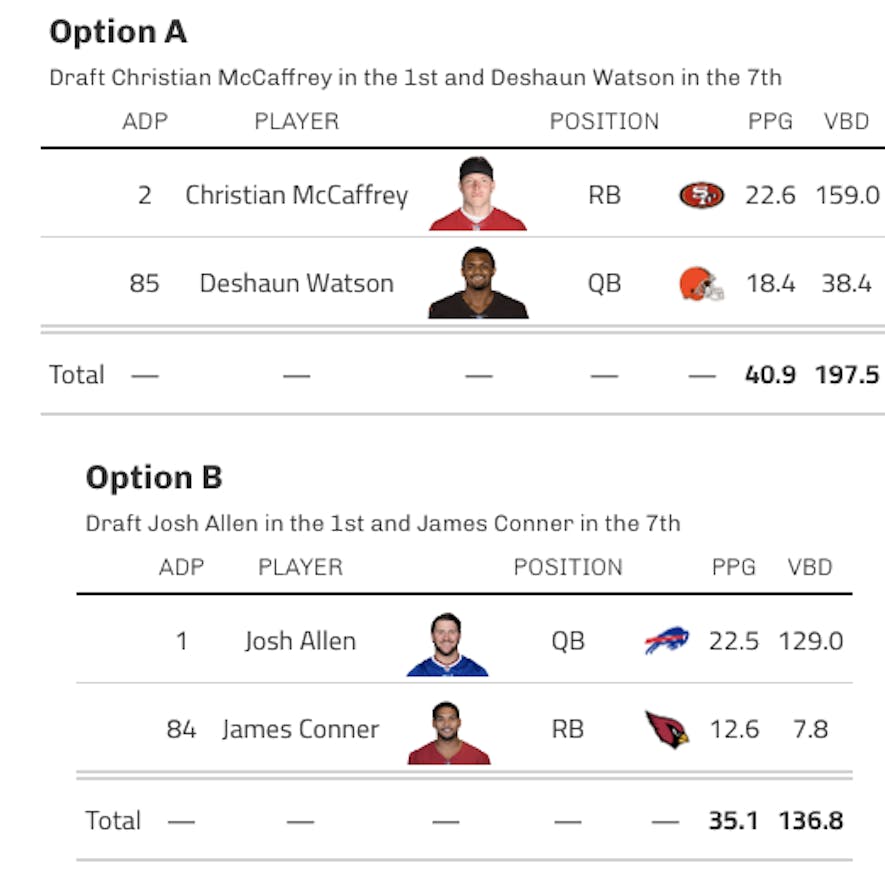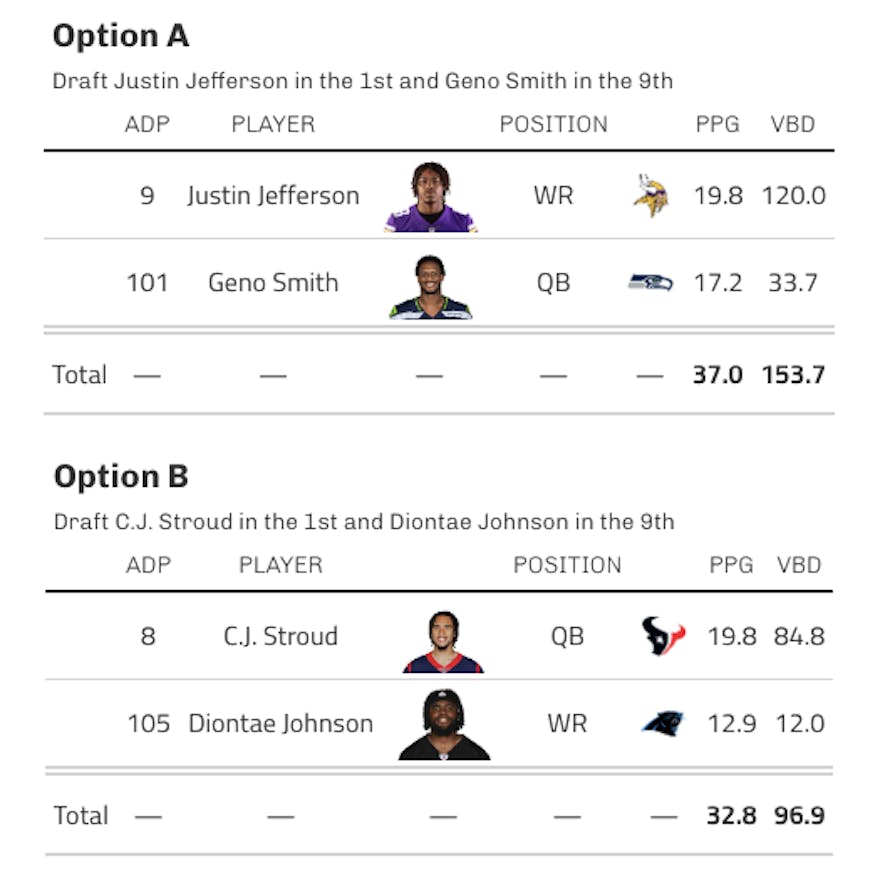Don’t draft a quarterback early in your 2024 Superflex Draft. We'll show you why.
The simple answer: Math.
More specifically, it's Supply and Demand and the math that determines the most important thing in your draft: Value.
The Average Draft Position (ADP) of the top quarterbacks is not justified when considering the tried-and-true principles of Value-Based Drafting (VBD). Unless a top quarterback falls to you multiple spots below his current ADP, you should target elite running backs and wide receivers in the early rounds of your Superflex draft.
Our Footballguys projections, which have consistently proven to be among the best in the industry, look very different in 2024 than in the past. The gap in fantasy production between the top quarterbacks and those who will be available later in drafts is projected to be significantly smaller this season. Your draft strategy should reflect these changes. You gain a significant competitive advantage by adjusting to the new reality quicker than your opponents. Here's why we recommend taking a new approach this season.
Dominating 2024 Superflex Drafts
The Basics of Value-Based Drafting
Joe Bryant introduced Value-Based Drafting (VBD) to the fantasy football world way back in 1996. The VBD system revolves around two things:
- Making detailed statistical projections for every draftable player. Don't worry if you don't feel up to making your own stat projections; we'll provide everything you need at Footballguys.com.
- Combining those detailed statistical projections with positional baselines to assign a value (VBD) to each player.
The guiding principle of VBD is the idea that a player's fantasy value is not determined by the number of points he scores but by how much he outscores the other players at his position.
Two vs. Two Examples
We can easily get deep into the math and theory of Value-Based Drafting, but it is easiest to illustrate with some examples based on actual decisions you may face in your 2024 Superflex Drafts.
Christian McCaffrey vs. Josh Allen
If you are lucky enough to have the 1.01 in your Superflex draft, you may be debating between Christian McCaffrey and Josh Allen. A good starting point for any fantasy decision is to look at fantasy projections. The Footballguys Consensus averages projections from some of the best and most accomplished fantasy analysts in the industry. Interestingly, McCaffrey and Allen project for almost identical fantasy production -- 22.6 and 22.5 fantasy points per game, respectively. If you look only at raw fantasy production, the decision between the two is a toss-up.
Drafting a winning team requires a deeper analysis than projecting fantasy points, however. We also need to contextualize that production and understand what it means for each position. Every position will have a different baseline. Before explaining how those baselines are determined, let's instead start by looking at it through the lens of a simple Option A or Option B choice. Here are two different ways you could spend your 1st and 7th-round picks in your Superflex Draft:
Even without calculating positional baselines or doing any fancy math, we can simply look at the combined PPG projections from the two pairs. We project McCaffrey and Deshaun Watson to combine for 40.9 fantasy points per game. We project Allen and James Conner to combine for 35.1 fantasy points per game. Drafting McCaffrey early and filling one of your QB/Superflex spots later gives you a massive weekly advantage.
This is VBD in a nutshell. The numbers strongly point to McCaffrey outscoring the other running backs by more points than Allen will outscore the other quarterbacks.
Justin Jefferson vs. C.J. Stroud
Let's keep going with another example. Let's say you have the 1.08 in your Superflex Draft and are deciding between a wide receiver and a top quarterback. In this example, let's assume that if we pass on Stroud, we will instead wait until the 9th round to fill one of our starting QB/Superflex spots. Similarly, if we do choose Stroud in the 1st, we will assume we wait until the 9th round to fill one of our starting WR/Flex spots.
Both Jefferson and Stroud project for almost identical fantasy production in a league with typical scoring. The advantage to drafting Jefferson is that you can easily add a quarterback who projects for 16 or 17 fantasy PPG later in the draft (like Geno Smith). On the other hand, you cannot find a wide receiver projected for 16+ fantasy PPG late in the draft. In fact, Footballguys projects just eight wide receivers to score 16+ fantasy points per game, and every single one of them currently has an ADP inside the Top 20 overall in Superflex drafts.
Replacement-level quarterback scoring is high. That is especially true in 2024 (more on this below). The baseline for quarterback scoring that we use to formulate VBD is higher than at any other position. This means that a quarterback like C.J. Stroud scoring almost 20 fantasy PPG will give us a much smaller overall edge against the competition than the same 20 fantasy PPG would give us from a wide receiver like Justin Jefferson.
These early-round draft decisions matter. They can be the difference between opening your Yahoo! fantasy app on Sunday morning and seeing you are a five-point favorite and opening it and seeing you are an underdog in your matchup.
Share This Article


